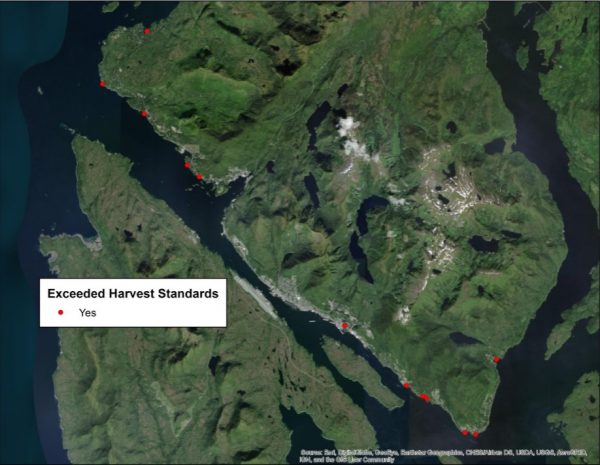
A dozen common shellfish harvest sites and recreational beaches in the Ketchikan area exceeded safe bacteria levels at least once this summer, according to a coalition of groups that monitor water quality.
This summer, the Southeast Alaska Watershed Coalition worked with Ketchikan Indian Community, the local federally-recognized tribe, to test Ketchikan-area beaches where people gather shellfish.
“All of them exceeded harvest standards at some point in the summer, and those are a little more stringent than just the recreation standards,” Rebecca Bellmore, the Juneau-based nonprofit’s science director, said at a public meeting Tuesday at the Ketchikan Public Library.
Bellmore also told the dozen or so people in attendance at the meeting that all but one site — South Point Higgins — also exceeded standards for safe recreation. Those standards are set by Alaska state law.
They tested for two types of bacteria: enterococci and fecal coliform. Neither are necessarily harmful to humans, but Bellmore says they’re common indicators of more serious contamination.
Fecal bacteria can come from a variety of sources, Bellmore says.
“These include public and private sewer treatment system outfalls, waste from boats at launches and harbors and out at sea, individual septic tanks that may be malfunctioning or leaking, pet and wildlife feces and cruise ships and ferries,” Bellmore said.
Some members of the public placed the blame on the hundreds of cruise ships that visit Ketchikan every summer.
But Bellmore and the acting head of the Department of Environmental Conservation’s cruise ship monitoring program, Denise Wiltse, pointed out that cruise ships are held to much higher standards for bacteria removal than local sources. While cruise ships must average less than 14 fecal colonies per 100 milliliters of wastewater, the city’s Charcoal Point Wastewater Treatment Facility is permitted to have a million fecal colonies in the same amount of water.
Weather could be a factor. Bellmore said the team saw spikes in bacteria — or “hot weeks” — after rainstorms. But the data wasn’t conclusive on that point.
“And then, interestingly, this July 2 date was also a ‘hot week,’ and that was in the middle of the hot drought — which is, like, opposite conditions,” Bellmore said.
Bellmore and other team members stopped short of recommending policy changes. But Sam Naujokas of Ketchikan Indian Community said these scientific results could help community members make their case for change.
“Call the borough, call the city, call the state and talk to them about it. Because a lot of this is happening on their land,” he said. “They’re the ones who post about it. This is a problem that they should be concerned about.”
The watershed coalition partnered with state regulators and the tribe for this summer’s testing. It was funded through the EPA’s BEACH Grant program.




